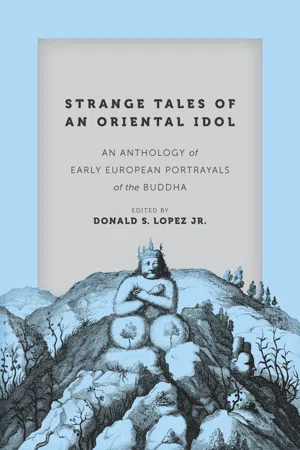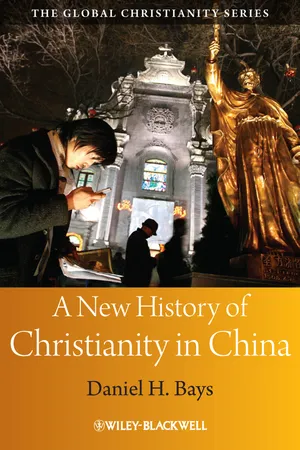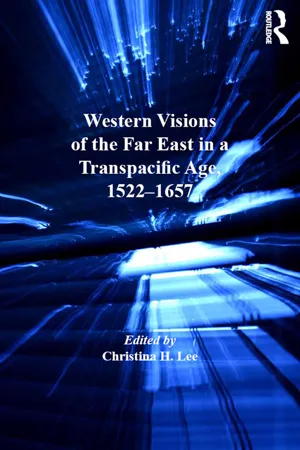History
Matteo Ricci
Matteo Ricci was an Italian Jesuit priest and missionary who played a significant role in the spread of Christianity in China during the late 16th and early 17th centuries. He is known for his efforts to integrate Christian teachings with Chinese culture and for his contributions to the understanding of Chinese language, culture, and science in the West.
Written by Perlego with AI-assistance
Related key terms
Related key terms
1 of 4
Related key terms
1 of 3
4 Key excerpts on "Matteo Ricci"
- eBook - ePub
Strange Tales of an Oriental Idol
An Anthology of Early European Portrayals of the Buddha
- Donald S. Lopez Jr., Donald S. Lopez Jr.(Authors)
- 2016(Publication Date)
- University of Chicago Press(Publisher)
CHAPTER THREEFrom 1601 to 1700
◆ Matteo Ricci (1552–1610)
The most famous of the many Jesuit missionaries to China was Matteo Ricci, who arrived in Macao in 1582. At the suggestion of a Chinese official, Ricci and his fellow priests adopted the appearance of Buddhist monks in order to be more immediately accepted. The Jesuits cropped their hair and shaved their beards and donned monks’ robes. They also described themselves as monks from the West; in China, the West often denoted India. However, in 1595, at the urging of his Chinese scholar friends and with the permission of his superior, Ricci and the Jesuits abandoned the dress of Buddhist monks—who, he reports, the Chinese held as “vile and lowly”—for the long beard and silk robes of the Chinese literatus. From that point onward, Ricci’s slogan would become qin ru pai fo, “Draw close to Confucianism and repudiate Buddhism.”Ricci criticized the Buddha and Buddhism in two works. The first was his catechism of 1603 written in Chinese, The True Doctrine of the Lord of Heaven (Tianzhu shiyi). The second was his history of Christianity in China, published posthumously (considered in a subsequent selection).The first passage below is Ricci’s ingenious reading of the famous Chinese story of how Buddhism first came to China. The emperor Ming (28–75 CE) of the Eastern Han dynasty is said to have had a dream of a golden flying man. One of his advisors explained that this was the sage of the West, called Buddha. The emperor sent a delegation to retrieve the teachings of this man (and, according to a later version of the story, a statue of him). Matteo Ricci argues that it was a case of mistaken identity.The second passage is drawn from Ricci’s attempt to refute the Buddhist doctrine of rebirth, which, as other Christian missionaries would do, he traces back to Pythagoras. Ricci devotes a long section to the refutation. He begins here by dismissing the doctrine—which he said the Buddha had taken from Pythagoras—because it comes from the insignificant and uncivilized land of India. - eBook - ePub
- Daniel H. Bays(Author)
- 2011(Publication Date)
- Wiley-Blackwell(Publisher)
The second ring road in today's Beijing is where the old city wall was, until the mid 1950s when Mao Zedong had the wall demolished. Just west of the former wall, only a short walk along Chegong E. Road, is a large compound which contains the Chinese Communist Party's Administrative College. Here officials on the fast career track receive training for high positions in the Party. In the middle of the courtyard is a walled-in graveyard, which many visitors are surprised to learn has the remains of over 60 Catholic missionaries of the Ming and Qing periods. The most prominent is the grave of Matteo Ricci, given pride of place in the arrangement of the tombstones. It was not always thus. Ricci (1552–1610), an Italian Jesuit who was the first Westerner to reside permanently in Beijing, after his death was honored by the Ming emperor with a gravesite outside Fuchengmen (the Fucheng gate). Ricci was joined by other Jesuits and missionaries of other Catholic orders over the next two or three centuries, including Adam Schall von Bell (1592–1666) and Ferdinand Verbiest (1623–1688), among other luminaries. In the violence of the Boxer Uprising in 1900 xenophobic mobs toppled the tombstones and desecrated the grounds. Then during the violent Red Guard phase of the Cultural Revolution in late 1966, youthful iconoclasts spurred to action by Mao's call to “destroy the ‘four olds,’” inflicted another round of mindless violence upon the site. In the “reform and opening” period since 1979, at first the cadres running the party school would occasionally arbitrarily permit well-known or well-connected visitors, including foreigners, to view the site, which was still in a disordered state. But then they realized their courtyard could be a source of income, even a cash cow. With the assistance of some foreign organizations and governments, many of them Italian, extensive repairs and restoration were done. And of course admission began to be charged. Today visitors and groups are systematically shown a 40-minute English DVD (also for sale) called simply “Matteo Ricci in China,” which praises Ricci for his commitment to “East-West cross-cultural exchange” without ever mentioning Christianity. Then the visitors are given a tour of the site and encouraged to take pictures. A foreign visitor who actually knows something about the historical events and personages represented in this fashion today can only shake her head and think, “the irony of it all.”Background and ContextFigure 2.1 Graves of Ricci, Schall von Bell, and Verbiest. Credit: Lou-Foto/Alamy.The third advent of Christianity in China, in which Christianity in China became a permanent part of the Chinese religious landscape, took place in the sixteenth century. It constituted a key transition in the worldwide serial movement of the Christian faith to parts of the non-West. It also was an important part of the first cross-cultural learning experience of the West.1 All this occurred as an extension to East Asia of historical forces sweeping Europe, most importantly the repercussions of the Protestant Reformation and the creation of the Portuguese and Spanish seaborne empires. These two factors combined to facilitate an unprecedented number of Christian missionaries coming to China in the late Ming and early Qing, and even more importantly the creation within China circa 1600–1900 of a surprising number of Christian communities, many of which proved quite resilient when the young Chinese church was outlawed and persecuted in the eighteenth century. This is the first period in which Chinese Christians start to become part of the historical record, visible in both Western and Chinese sources from about 1600 onward.2 - Simon Estok, Jonathan White, I-Chun Wang(Authors)
- 2016(Publication Date)
- Routledge(Publisher)
As in this chapter I am focusing on one text by Ricci, it is important briefly to give a sense of some of his other work. The Library of Congress Vatican Exhibit includes a commentary of an item (Barb. or. 142, fasc. 3, chuan 2 fols. 32b – 33a china09 HG.06) under Matteo Ricci, Hun-kai t`ung-hsien t`u-shuo, that states: “Matteo Ricci’s technical explanation in Chinese of European astronomy was no doubt written with the help of his friend Li Chih-tsao, who contributed a preface. Notice the main circle’s division into the 12 houses and their polar projection. The work contains a preface by Ricci, as well as one by Li Chih-tsao, with a postscript by another Chinese friend. The prefaces give only the rough date ‘the end of the Wan-li reign’ (i.e., ca. 1610–1620).” There was, then, collaboration between Ricci and his Chinese colleagues. But there was not unity of approach even within the Jesuit missions to China, as Ricci seems to have preferred scholars with the Confucian tradition while Michele Ruggieri favored those in the Buddhist and Daoist traditions. Ricci was more adept at the Chinese language than Ruggieri (see Dunne; Saraiva and Jami). The holdings in the Vatican Library, as an exhibition at the Library of Congress, suggests the intricacy of the relation between the Jesuits and China: “But the Vatican’s holdings wonderfully exemplify the fragile, fascinating bridge of texts and images which the Jesuits built in order to reach, understand—and convert—the most foreign of cultures” (“Rome Reborn”)- Christina H. Lee, Christina H. Lee(Authors)
- 2016(Publication Date)
- Routledge(Publisher)
41 Scholars of modern sinology are in accord that a fundamental change occurred when these missionary-scholars set to the task of learning the Chinese language and evaluating the compatibility of indigenous philosophical systems with the Christian message. There is ample proof that the Jesuits read and understood Chinese texts, beginning with the first priests who sought to establish a foothold in China in the early 1580s. Yet the fruits of their studies would not become apparent to other scholars in Europe or elsewhere until the early seventeenth century. It was after Matteo Ricci had won the Jesuits a firm foundation in Beijing that his fellow missionaries began to publicize his (and their) apostolic efforts. The most famous of these texts, nevertheless, contain a mixture of personal impressions, cultural observations, and mission history, making it difficult to identify their sinological content.41 For further information on the study of Chinese language and literature by Jesuit missionaries, see Brockey, Journey to the East 243–86.Matteo Ricci’s journals, rendered in Latin by his confrere Nicolas Trigault (1577–1628) and published as De Expeditione Christiana apud Sinas [The Christian Expedition to China] (first edition Augsburg, 1615), and Álvaro Semedo’s Imperio de la China i cultura evangelica en él por los religiosos de la Compañía de Iesus [Empire of China and the Cultivation of the Gospel in it by the Religious of the Society of Jesus] (first edition Madrid, 1642 ) both mention Chinese books, but give few titles and fewer translations. Despite the fact that the goal of these authors was to record the triumphant march of the Catholic faith, Ricci and Trigault do cite their use of “a Description of the Chinese Empire, written in 1579” for geographical data; a “voluminous book on Chinese funeral rites” and “two calendars […] edited every year” for ritual questions; and claim to have pursued the “diligent study of the history of China,” including “ancient Chinese annals.”42 Semedo (1585–1658) likewise mentions printed descriptions of the Chinese language, in particular a haipian, or vocabulary list, and also offers a description of the Confucian Four Books.43 And despite the fact that it has been shown that the Jesuits had a substantial library of Chinese books at their Nanjing residence before 1616, their missionary activities do not appear to have permitted them to spend much of their time divulging this information to the European reading public.44
Index pages curate the most relevant extracts from our library of academic textbooks. They’ve been created using an in-house natural language model (NLM), each adding context and meaning to key research topics.
Explore more topic indexes
Explore more topic indexes
1 of 6
Explore more topic indexes
1 of 4



